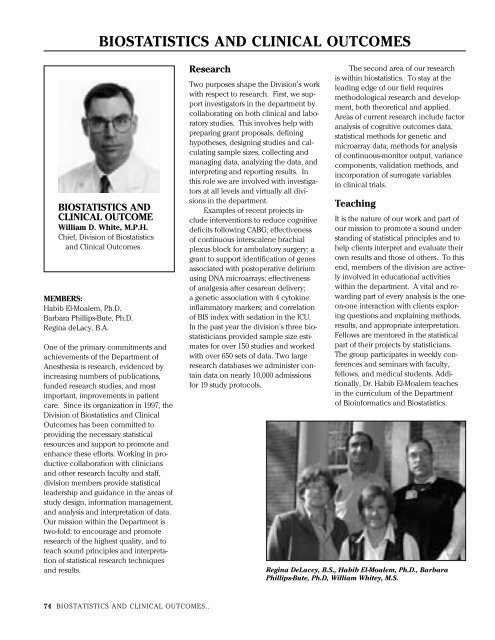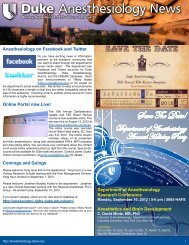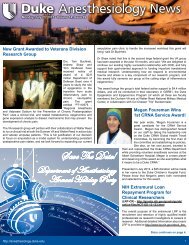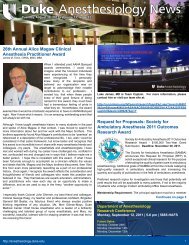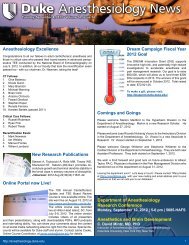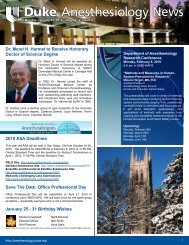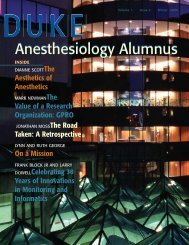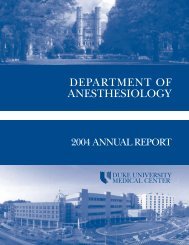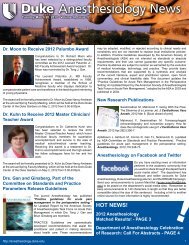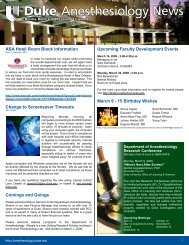DEPARTMENT OF ANESTHESIOLOGY ANNUAL REPORT
DEPARTMENT OF ANESTHESIOLOGY ANNUAL REPORT
DEPARTMENT OF ANESTHESIOLOGY ANNUAL REPORT
Create successful ePaper yourself
Turn your PDF publications into a flip-book with our unique Google optimized e-Paper software.
BIOSTATISTICS AND<br />
CLINICAL OUTCOME<br />
William D. White, M.P.H.<br />
Chief, Division of Biostatistics<br />
and Clinical Outcomes<br />
MEMBERS:<br />
Habib El-Moalem, Ph.D.<br />
Barbara Phillips-Bute, Ph.D.<br />
Regina deLacy, B.A.<br />
BIOSTATISTICS AND CLINICAL OUTCOMES<br />
One of the primary commitments and<br />
achievements of the Department of<br />
Anesthesia is research, evidenced by<br />
increasing numbers of publications,<br />
funded research studies, and most<br />
important, improvements in patient<br />
care. Since its organization in 1997, the<br />
Division of Biostatistics and Clinical<br />
Outcomes has been committed to<br />
providing the necessary statistical<br />
resources and support to promote and<br />
enhance these efforts. Working in productive<br />
collaboration with clinicians<br />
and other research faculty and staff,<br />
division members provide statistical<br />
leadership and guidance in the areas of<br />
study design, information management,<br />
and analysis and interpretation of data.<br />
Our mission within the Department is<br />
two-fold: to encourage and promote<br />
research of the highest quality, and to<br />
teach sound principles and interpretation<br />
of statistical research techniques<br />
and results.<br />
Research<br />
74 BIOSTATISTICS AND CLINICAL OUTCOMES..<br />
Two purposes shape the Division's work<br />
with respect to research. First, we support<br />
investigators in the department by<br />
collaborating on both clinical and laboratory<br />
studies. This involves help with<br />
preparing grant proposals, defining<br />
hypotheses, designing studies and calculating<br />
sample sizes, collecting and<br />
managing data, analyzing the data, and<br />
interpreting and reporting results. In<br />
this role we are involved with investigators<br />
at all levels and virtually all divisions<br />
in the department.<br />
Examples of recent projects include<br />
interventions to reduce cognitive<br />
deficits following CABG; effectiveness<br />
of continuous interscalene brachial<br />
plexus block for ambulatory surgery; a<br />
grant to support identification of genes<br />
associated with postoperative delirium<br />
using DNA microarrays; effectiveness<br />
of analgesia after cesarean delivery;<br />
a genetic association with 4 cytokine<br />
inflammatory markers; and correlation<br />
of BIS index with sedation in the ICU.<br />
In the past year the division’s three biostatisticians<br />
provided sample size estimates<br />
for over 150 studies and worked<br />
with over 650 sets of data. Two large<br />
research databases we administer contain<br />
data on nearly 10,000 admissions<br />
for 19 study protocols.<br />
The second area of our research<br />
is within biostatistics. To stay at the<br />
leading edge of our field requires<br />
methodological research and development,<br />
both theoretical and applied.<br />
Areas of current research include factor<br />
analysis of cognitive outcomes data,<br />
statistical methods for genetic and<br />
microarray data, methods for analysis<br />
of continuous-monitor output, variance<br />
components, validation methods, and<br />
incorporation of surrogate variables<br />
in clinical trials.<br />
Teaching<br />
It is the nature of our work and part of<br />
our mission to promote a sound understanding<br />
of statistical principles and to<br />
help clients interpret and evaluate their<br />
own results and those of others. To this<br />
end, members of the division are actively<br />
involved in educational activities<br />
within the department. A vital and rewarding<br />
part of every analysis is the oneon-one<br />
interaction with clients exploring<br />
questions and explaining methods,<br />
results, and appropriate interpretation.<br />
Fellows are mentored in the statistical<br />
part of their projects by statisticians.<br />
The group participates in weekly conferences<br />
and seminars with faculty,<br />
fellows, and medical students. Additionally,<br />
Dr. Habib El-Moalem teaches<br />
in the curriculum of the Department<br />
of Bioinformatics and Biostatistics.<br />
Regina DeLacey, B.S., Habib El-Moalem, Ph.D., Barbara<br />
Phillips-Bute, Ph.D, William Whitey, M.S.


